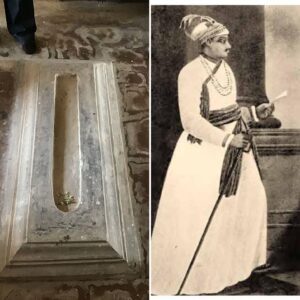It is often said that tales are inspired by real-life stories but there are also certain tales that hardly anyone remembers. I don’t do history topics but I wanted to do this article for a long time.
This is the real tragic tale that had survived the greatest betrayal in Indian History. This tale is of Nawab Siraj-ud-Daulah, the Last Independent Nawab of West Bengal (India), and his second wife Lutfunnisa Begum.

Unfortunately, we don’t have any portrait of Lutfunnisa Begum.
Nawab Siraj-ud-Daulah
Siraj-ud-Daulah was born in 1733 in Murshidabad West Bengal (India). He was born and brought up in his maternal grandfather’s palace and was given all necessary education and training suitable for the future Nawab. It is also said in many verses that Siraj-ud-Daulah was a ‘fortune child’ for his family. His maternal Grandfather Alivardi Khan was very much fond of him as well. He declared Siraj as his successor. After Siraj-ud-Daulah’s maternal grandfather Alivardi Khan died in 1756, he succeeded him at the age of 23. It is often said that Siraj-ud-Daulah was very much immature, whimsical leaning and ambivalent, he had numerous sorts of deformities in his character and lead. He had pompous conduct and an unchangeable temper. As India was then under British rule, it was also said that Siraj-ud-Daulah was greatly known for his ill-fame. He was regularly named as a beast of savagery and wickedness by Lord Clive. Siraj-ud-Daulah did not rule for a long time. His reign began on 9 April 1756 and it ended on 23 June 1757. He was betrayed by his own grand-uncle Mir Jafar, during the battle of Plassey following which the British won the battle. Siraj-ud-Daulah had to flee as no one supported him anymore and he had no powers. When Siraj was fleeing towards Patna on boat with his beloved wife and some loyal attendants, he was arrested by Mir Jafar’s soldiers. He was executed on 2nd July 1757, under the order of Mir Jafar’s son. He was hardly 23-24 years old, then.
You may also like: https://www.withlovemoni.com/may-be-someday-by-monidipa-dutta/
Lutfunnisa Begum
Lutfunnisa Begum’s original name was Rajkunwar, she was a Hindu girl who served Siraj’s mother. It is unknown about her past and parents. Rajkunwar was extremely beautiful and had aesthetically pleasing manners. Siraj-ud-Daulah was deeply attracted by her. He fell in love with her eventually and asked his mother to give her to him. It is said in some verses that Siraj’s mother liked Rajkunwar but was not happy when Siraj asked for her but she loved her son dearly so she finally gave in. Siraj married Rajkunwar and renamed her Lutfunnisa Begum. Lutfunnisa Begum was Siraj-u-Daulah’s second wife. Siraj’s first wife Umdatunnisa (Bahu Begum) kept herself busy in merrymaking. She never bore Siraj any children. Lutfunnisa Begum bore him with a daughter named Umme Zohra.
It was always known that Nawab Siraj-ud-Daulah was very much loyal and fond of Luftunnisa Begum but in certain verses, it is mentioned that Lutfunnisa Begum was also a lady who spoke her mind.
There is also a story (though not confirmed) that Nawab Siraj-ud-Daulah’s diwan (minister)’s sister Madhabilata was kidnapped at her younger age, when she grew up she was appointed as a dancer by Mir Jafar and was renamed Faizi Bai, she was sent by the East India company to spy on the Nawab and was offered to pay a very handsome amount if she could assassinate him. Although Nawab suspected her still he never confronted her, when Lutfunnisa Begum came to know about it she was extremely upset. As Nawab Siraj-ud-Daulah was very fond of his wife so he immediately arrested Faizi Bai.
It is said that Lutfunnisa was not only beautiful but very much intelligent as well. She guided her husband in each progression to shield Bengal’s Masnad from rebellion and monstrosities by adversaries inside and outside the Royal Palace of Murshidabad.
Aftermath
After Siraj-ud-Daulah lost the battle of Plassey in 1757, he sent all the women of his harem away under the protection of Diwan Mohanlal but Lutfunnisa urged that she would accompany him. He loved her so dearly that he could not say no to her. After Siraj-ud-Daulah was arrested and murdered, both Mir Jafar and his son-in-law tortured Lutfunnisa so that she would disclose the location of the hidden jewels, but she never said anything. She was sent with her daughter Umme Zohra to the Jinjira Palace in Dhaka Bangladesh where they were kept under strict surveillance. In 1765 she was released and brought back to Murshidabad. Then the East India Company started her regular pension.
It is also said that on various occasions she had received offers for marriage by Mir Jafar and his son Miran, but she always rejected them, not only because she was a dignified lady but also because she loved Siraj-ud-Daulah.
Lutfunnisa Begum led a long life, faced a lot of hardship as when her daughter Zohra Begum and her son-in-law Mir Asad Ali Khan died in 1774 she was left with the guardianship of their 4 daughters.
Lutfunnisa Begum died on 10 November 1790, at the age of 49-50 and was buried in Khushbagh by the side of her husband.

I know it was not a picture-perfect fairy tale. But I chose to put this on the page because I feel, this is how love and loyalty look like. Siraj-ud-Daulah was head over heels for his second wife who was also his principal consort, but after Siraj-ud-Daulah died she could have chosen otherwise. I mean, if you see, Lutfunnisa Begum was pretty young when she got married to Siraj-ud-Daulah. And when he deceased, she was still beautiful and intelligent. She could have led a good and glorious life after Siraj-ud-Daulah was executed but still she decided to live as his widow, to honor his memory. And maybe that is how true love should look like…
So, what are your thoughts on it?
Let me know…
⁕ ⁕ ⁕
References:
Wikipedia about Siraj-ud-Daulah
Wikipedia about Diwan Mohanlal
Picture Courtesy of Lutfunnisa and Siraj-ud-Daulah’s Photos:
Wikipedia.org



Oh wow! This was such an amazing read. I’m a huge history buff, and I love learning about things that are off the beaten path like this.
What a story! It’s so beautiful and terrible at the same time. It was a very interesting read. I’d never heard about this before in any history book.
A great example of love an loyalty for sure. Thanks for sharing such an amazing story, I knew nothing about.
This is sooooo beautiful, what an amazing story! Thank you so much for sharing this awesome story with us.
This is a unique love story for sure. One that I had never heard of. She was a brave woman to stand with her husband during tough times.
I have never hear about this love story before. I love learning new things. Thank you for sharing!
I enjoy reading stories like this. Life it’s hard as well as relationships too so not every story ends on a rosy note. Though love always prevails.
A very touching true story. After reading this I searched about Lutfunnisa on the internet. This touches me emotionally more than all fairy tales.
I feel so sad for all of the difficulty she went through. She lived a very hard life but yet stayed so dignified.
This is a very insightful & thought prevoking piece. As a bengali myself, I can make sense of the nuances with this story. Thank you for sharing this tale which relates to my heritage.
I really enjoy reading this story, it’s beautiful, it is not really a perfect love story but I can say true love really exist.
I always like things that are historical, such as about the heroism, romance and ancient customs or culture. The story above has similarities with the old story in my country, warfare, intriguing romance, the story of a woman who struggled to become a mother and wife with an intelligence that was considered unworthy in ancient times.I like this story, there is many moral messages in there.
I wasn’t aware of this story prior to read this post. I learned so much an was very intrigued all throughout.
haha I’m pretty sure that we can’t remember this one, as it happene in 1933
you are spot on , i have never hear of this love story before , an i am happy to rea it too – it was mesmerising
This is an amazing love story. I wish that this will be shared even more, like in a form of a book, movie, or even a TV series. I enjoyed reading the historical/period love story.
Wow. I am a sucker for love stories. Thanks for sharing.
Goo job. We must all take our time to make sure the history of our ancestors stay a live. I am Native American, an we pass own history in stories too.
This really is a beautiful story of loyalty in its own right. Thank you for sharing their story, it is one that I had not previously heard. I can’t imagine the pain she would have felt when he was executed.
Such an interesting story, I always enjoy reading historical stories about brave women of their time.
An interesting read it is
Such a fascinating story … was unaware of Lutfunnisa Begum and her love and loyalty for Suraj-ud-daulah. The world only knows him as a victim of betrayal by his uncle, so glad to come across this unknown love story. Thank you for digging this out and sharing it.
This is so tragic but I love what you said at the end. Her love for him was real and it could never be replaced with wealth and fortune from another man. She chose to stick by his side no matter how hard it was.
Love how she can be so strong and stand by the man she loves. Beautiful story worth telling to the next generation.
very interesting! such a nice read, very enriching to me!
So much rich history in India. I’m almost finished with my book “autobiography of a yogi” and have loved learning about the rich Indian culture.
Oh wow, I appreciate you sharing this love story with us!
History of our country has many love stories – this is an epic one. Happy you wrote about it & I agree that yes she was truly in love & that’s what relation is all about.
Such an interesting story. Thanks for sharing!
This was an amazing story!!!
This is such a romantic story & sad at the same time!
Interesting . Indeed this story describes the definition of love and loyalty.
I did not know about this love story. Too bad he was executed. Thanks for sharing!
I love any love story and you know I enjoyed this one.
Thank ypu so much for writing this, as I am into my history so love reading and learning about times like this x
I love reading about historic love stories! I haven’t heard about this one so it was an interesting read.
This is an amazing story and a very example of loyalty. First time I hear about it and it was a good reading. – Paolo
Wow! I am such a fan of history. This was such a lovely story – I’ve never heard of this before! Thank you so much for sharing this with us.
For a woman to such such tragedy yet remain dignified to the very end is one of great stature.
Quite a love story indeed!
What a touching love story. One I won’t soon forget!
first time i read about this,,,very inspiring at he same time a tragic one…but we never know that this situation are still happening right now in a different perspective
It is not like the fairytale love stories we always hear but I think it is just as beautiful.
Wow – what a great example of excellent storytelling – because not only the story itself is intriguing, it’s many your narration that makes it so powerful. Thank you 🙂
Our ancient history has so much to give.glad to read this interesting story.
This is such a beautiful and awful the same time love story. I’m not fan of love story but I enjoyed this one 🙂
Thanks for this anecdote and yes, I have no idea about these people and I learn something new from your blog today. – Knycx Journeying
I never heard this story earlier. I love to read such stories and this is very interesting story. Thanks for sharing
True love withstands the test of time. This is yet another example. Thanks for sharing this love story that no one remembered. Hopefully, this will be a step towards finding out countless number of unsung heroes in our country, whose stories need to be told.
This was an interesting story but I don’t know if I can say a fairytale. I actually feel sorry she died fairly young and never got remarried.
I once read about Siraj-ud-daulah in my history books. But, didn’t heard about this beautiful love story before.
I like reading history. It was great read for me!
I never knew about this story before, I love the story. Thank you for sharing.
Most fairytales aren’t picture perfect. This was a very sweet story.
Hadn’t heard of this story ever. During the British raj, so much tragedy took place that such stories are an insight into the dark and light sides of humanity.
She had a tough life surely when she saw so much just in 50 years.
Thank you for sharing this story. I have not heard it before. Very interesting look at relationships back then.
Such a fascinating post. I have never heard of this love story. I don’t think I would classify it as a fairytale… it is sad she died so young.
This was such an interesting story to read, I don’t think I’ve ever heard of it, thanks for sharing !
WOW, such an amazing rea! I’m a huge fun of history an love to rea such a stories.
Hmm, well I don’t believe there is any particular way love or relationships should look like, I think there are choices people make… and that is there individual experience. I do like some historical romance, though! Thanks for this.
What a great tragedy type story! I loved it cause I originally thought that Lutfunnisa was going to be the betrayer but rather it was Siraj’s uncle Mir! How sad that they had him executed though but I do love the continuing story of Lutfunnisa and her loyalty and love of Siraj til the end!
This is my second reading that beautiful story and it melts my heart again.
Woow…Thanks for sharing this amazing love story, i wasn’t aware of this until I read this here. cheers, siennylovesdrawing
Wow. This was both lovely and sad at the same time but I thoroughly enjoyed reading this. Thanks for sharing!
How did her daughter and son in law die?
Her son in law died during Afghan rebels, daughter died as she was ill!
Exploring the forgotten tale of Nawab Siraj-ud-Daulah and his wife Lutfunnisa Begum, a story of tragedy and betrayal in Indian history. A topic worth delving into!